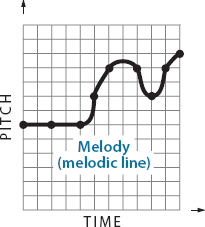2 | Melody

A melody is an organized series of pitches. Melodies can be built from any scale. Think for a moment of pitch and time as the two coordinates of a musical graph (see the diagram shown in the margin). A series of single pitches played in a certain rhythm will appear as dots, high or low, on the pitch/time grid. If we connect them by a line, we get a picture of the melody’s overall shape or contour. And in fact, musicians commonly speak of “melodic line,” or simply line, in this connection.
Melodies come in an unlimited array of shapes, and they convey a huge variety of emotional characters. A melody involving a leap from low notes to high can seem to soar; a low note can feel like a setback; a long series of repeated notes on the same pitch can seem to wait ominously. The listener develops a real interest in how the line of a satisfactory melody is going to come out.
“Always remember that in listening to a piece of music you must hang on to the melodic line. It may disappear momentarily. . . . But reappear it surely will.”
Composer Aaron Copland, 1939 (see page 349)
Of all music’s structures, melody is the one that moves people the most, that seems to evoke human sentiment most directly. Familiar melodies register simple qualities of feeling instantly and strongly. These qualities vary widely: strong and assertive — like a bugle call — in “The Battle Hymn of the Republic,” mournful in “Summertime” or “Yesterday,” serene in “Amazing Grace,” extroverted and cheerful in “Happy Birthday.”